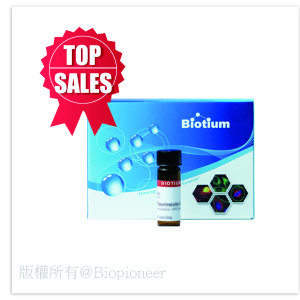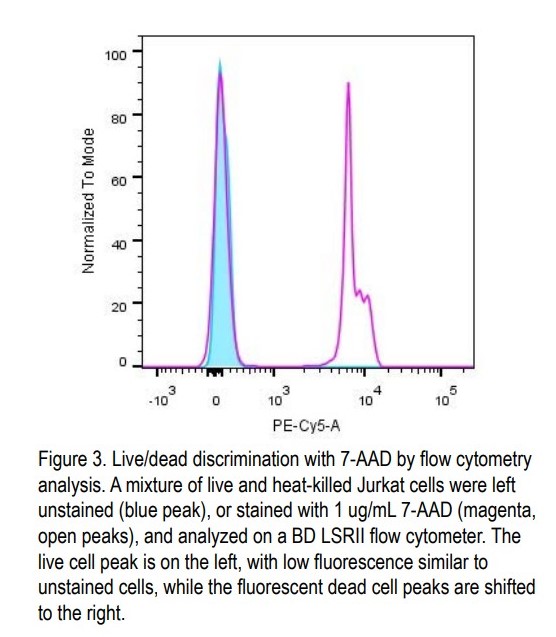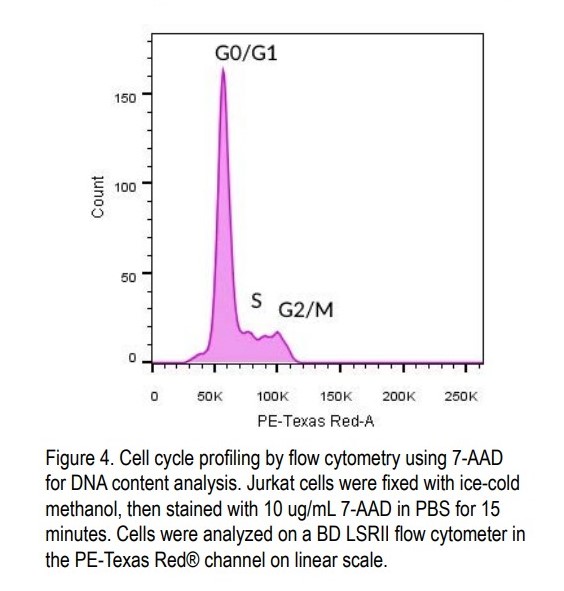細胞介導的細胞毒性螢光檢測(7-AAD / CFSE)| 貨號K315-100 (Abcam, ab287870)

| 代理廠牌: |  |
| 原廠連結: | |
| 相關下載: |
細胞介導的細胞毒性螢光檢測試劑盒(7-AAD / CFSE)| 貨號K315-100 (Abcam, ab287870)
Cell-Mediated Cytotoxicity Fluorometric Assay Kit (7-AAD/CFSE)- Direct assay to measure cell-mediated cytotoxicity,

產品描述:細胞介導的細胞毒性是一種重要現象,其特徵在於免疫系統對體內受損細胞的細胞溶解(cytolysis)。 免疫系統激活,去除被病原體或轉化細胞/癌細胞感染的靶細胞。 該過程由抗體依賴性細胞介導的細胞毒性(antibody-dependent cell-mediated cytotoxicity , ADCC),complement-mediated cytotoxicity補體介導的細胞毒性或淋巴細胞介導(lymphocyte-mediated cytotoxicity)的細胞毒性介導。 BioVision的Cell-Mediated Cytotoxicity Assay Kit細胞介導的細胞毒性檢測試劑盒包含羧基氟琥珀酰亞胺酯(carboxyfluorosuccinimide ester , CFSE),一種標記活靶細胞的綠色螢光探針和7-氨基放線菌素D(7-aminoactinomycin D , 7-AAD),一種红色螢光探針,可標記細胞毒性中死亡的晚期凋亡和壞死靶細胞檢測。該測定不需要細胞裂解並且提供細胞毒性的直接測量,而不是間接指示,例如ATP或乳酸脫氫酶活性的釋放。 基於流式細胞術的方法提供了強大的數據並支持多參數分析。

| Cat # +Size | K315-100 |
| Size | 100 assays |
| Detection Method | Fluorescence (FL1 channel and FL3 channel) |
| Applications | Measurement of cell cytotoxicity in response to drug or toxin treatment Quantification of the cytotoxic effect of immune effector cells on target cells Assessment of physiological mediators and antibodies that affect cell cytotoxicity |
| Features & Benefits | • Direct method to measure cell-mediated cytotoxicity. • Does not require cell lysis. • Provides multi-parametric analysis. |
| Kit Components | • Cytotoxicity Assay Buffer • 7-AAD Staining Solution • CFSE Staining Solution |
MCE (MedChem Express) -Y-320 /orally active phenylpyrazoleanilide immunomodulator
MCE總部位於美國新澤西,提供種類齊全的化學及生化研究用產品,包括創新的生命科學試劑,reference compounds(標準化合物),APIs(原料藥)及Natural compounds(天然化合物)以提供實驗室或科學研究之用,MedChemExpress(MCE)產品50000+ 特異性抑制劑、化合物庫、重組蛋白,專注於信號通路和疾病研究領域。全球文獻廣泛引用,質控體系嚴格,品質100%。

CFSE | CAS#150347-59-4 MCE貨號HY-D0938
(Synonyms: 5(6)-Carboxyfluorescein diacetate succinimidyl ester; 5(6)-CFDA N-succinmidyl ester)
CFSE 是一種可以穿透細胞膜的螢光染料(fluorescent dye )。它能與細胞內細胞骨架蛋白( cytoskeleton protein)中的游離氨基(free amine group)發生反應,最終形成具有螢光的蛋白複合物。 CFSE進入細胞後分佈於細胞膜( cell membrane)、細胞質(cytoplasm)和細胞核(nucleus)中,其中細胞核內的螢光染色最強。 CFSE染料可被細胞分裂增殖的細胞均勻遺傳,其衰減與細胞分裂次數成正比。這種現象可用488nm激發光下的流式細胞術檢測分析,可用於檢測細胞的增殖( proliferation)情況。






7-AAD (7-aminoactinomycin D) 螢光 DNA 結合染料 | Biotium 貨號40084 (1mg/ml)
7-AAD(7-氨基放線菌素 D, 7-aminoactinomycin D)是一種膜不可滲透(membrane-impermeant )的螢光 DNA 結合染料,可用於通過流式細胞儀( flow cytometry) 進行活/死細胞區分( live/dead discrimination )和細胞週期分析(cell cycle profiling)。7-AAD 是一種螢光 DNA 結合染料(fluorescent DNA binding dye ),不透膜(membrane impermeant ),因此通常被活細胞( live cells )和早期凋亡細胞( early apoptotic cells)排除,但會染色壞死( necrotic )和晚期凋亡細胞(late apoptotic cells ),膜完整性受損( membrane integrity)。

與 DNA 結合的 7-AAD 在激發/發射波長為 546/647 nm 時具有較大的Stokes shift 。染料可以用 488 nm 或 532 nm 激光線激發,並在 PE-Cy®5/PerCP 流式細胞儀通道中檢測。 7-AAD 廣泛用於區分活細胞/死細胞。它還可用於固定和透化細胞,通過使用流式細胞儀進行 DNA 含量分析來進行細胞週期分析。 7-AAD 選擇性地嵌入富含 GC 的 DNA 區域,使其染色可用於染色體顯帶研究。我們提供固體粉末形式的 7-AAD(貨號 40037)或 1 mg/mL DMSO: 水 (1:1) 溶液(貨號40084)。建議使用 1 ug/mL(1:1000 稀釋)的染料來檢測活/死細胞或 10 ug/mL(1:100 稀釋)用於細胞週期分析。


7-AAD (7-aminoactinomycin D) is a membrane-impermeant fluorescent DNA binding dye that is useful for live/dead discrimination and cell cycle profiling by flow cytometry.
- Selective detection of dead cells by flow cytometry in the PE-Cy®5/PerCP channel
- Perform cell cycle profiling by flow cytometry in fixed/permeabilized cells
- λEx/λEm (with DNA) = 546/647 nm (7-AAD can also be excited by the 488 or 532 laser lines)
- Orange red solid soluble in DMF or DMSO
- Store at -20°C and protect from light, especially in solution
- C62H87N13O16
- MW: 1270.45
建議使用
建議使用 1 ug/mL(1:1000 稀釋)的染料來檢測活/死細胞或 10 ug/mL(1:100 稀釋)用於細胞週期分析
We recommend using the dye at 1 ug/mL (1:1000 dilution) for live/dead discrimination or 10 ug/mL (1:100 dilution) for cell cycle profiling. Example protocols are provided below.


| Product | Catalog Number | Unit Size | Format |
|---|---|---|---|
| 7-AAD | 40037 | 1 mg | Orange/red solid |
| 7-AAD Solution, 1 mg/mL | 40084 | 1 mL | Red solution in DMSO:Water (1:1) |
Experimental Protocols
For live/dead discrimination by flow cytometry
1. Prepare a positive control by incubating cells at 56°C for 30 minutes then cool to room temperature. Include an untreated cell sample as a negative control.
2. Adjust cells to 5×106 cells per mL in complete culture medium or buffer of your choice and aliquot 1 mL per flow tube. Note: Cells can be stained anywhere between 5×105 cells/mL to 107 cells per mL in 100 uL to 1 mL. If necessary, a 100 ug/mL intermediate dilution of 7-AAD can be prepared by diluting the stock solution 1:10 in water or buffer.
3. Add 1 uL of 1 mg/mL 7-AAD to 1 mL of cells and mix.
4. Incubate 15-30 minutes at room temperature, protected from light. The incubation can be carried out on ice if desired.
5. Analyze by flow cytometry in the PE-Cy®5 or PerCP channel without washing the cells.
Notes: a. While 7-AAD staining is retained after formaldehyde fixation, separation between live and dead cells is reduced after fixation due to dye transfer from dead to live cells. For truly fixable dead cell staining, we recommend using a covalent dye such as our Live-or-Dye™ stains (see Related Products). b. This protocol was optimized using Jurkat cells. Assay optimization may be required for use with other cell types. c. If you prefer not to wash your cells, staining can be performed in cell culture medium with serum instead of buffer.
For cell cycle profiling by flow cytometry analysis of DNA content
Materials required but not provided (see Related Products)
• Flow Cytometry Fixation/Permeabilization Kit (catalog no. 23006)
• 1X Phosphate buffered saline (PBS) or your preferred FACS buffer Staining Protocol
1. Adjust cells to 107 cells per mL and aliquot 100 uL per flow tube.
2. Fix and permeabilize cells according the protocol for the Flow Cytometry Fixation/Permeabilization Kit, or use your preferred method.
3. Pellet the cells by centrifugation and wash with 1X PBS or FACS buffer.
4. Pellet the cells by centrifugation and resuspend in 100 uL buffer.
5. Add 1 uL of 1 mg/mL 7-AAD per tube and mix by gentle vortexing.
6. Incubate 15 minutes at room temperature, protected from light.
7. Add 400 uL PBS or FACS buffer per tube. Analyze by flow cytometry in the PE-Cy®5 channel or PerCP channel. Use a linear scale for fluorescence detection, and acquire data with a slow flow rate (~12 uL /minute).
1. Environ Mol Mutagen (2013) 54(8), 682-9. doi: 10.1002/em.21800
2. Mol Cell Biol (2014) 34(24), 4485–4499. doi: 10.1128/MCB.00671-14
3. Mutat Res Genet Toxicol Environ Mutagen (2014) 770, 1-5. doi: 10.1016/j.mrgentox.2014.05.001
4. Science (2017) 356(6339) eaai9264. DOI: 10.1126/science.aai9264
5. Int J Rad Biol (2019) 95,9, 1226-1235. DOI: 10.1080/09553002.2019.1625490
6. OncoTargets Therapy (2019) 12, 5227-5239. https://doi.org/10.2147/OTT.S190460
7. Antioxidants (2020) 9(9), 873. doi:10.3390/antiox9090873
8. Antioxidants (2020) 9(9), 876. doi:10.3390/antiox9090876